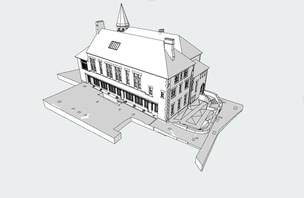I’VE regularly voiced my opinions on manufacturers’ seemingly unquenchable thirst for honing their latest, greatest performance car on 12-and-a-bit miles of German track nestled in the Eifel mountains.
There’s a similar routine: an email will ping into a journalist’s inbox from a hyper-active PR officer containing a car’s lap time around the fabled Nurburgring Nordschleife circuit, like that somehow means it’s better than everything else… even though the majority of us will never drive on a track in our life.
If a car’s good, a car’s good - I’m not a fan of headline-grabbing power outputs or indeed the time it takes to get around a track, regardless of how undeniably taxing the Nurburgring is on a car’s brakes and suspension in particular.
A marque not known for its performance cars is Hyundai, the firm which attempted to hijack my growing love of all things motoring when I was an impressionable six-year-old when my mother and step-dad lost their minds and bought an N-registered Hyundai Accent. However, their first crack at the highly competitive hot hatch sector, the i30 N, is something they ought to be rather proud of.
That ’N’ on the end of its name stands for two things, firstly the brand’s home in Namyang, South Korea, and also the aforementioned German circuit, which is where the pumped-up version of the i30 underwent testing in preparation for its head-to-heads with hot hatch contenders from Honda, Peugeot, Renault, Seat and VW.
While badge snobs will undoubtedly maintain their uneducated sneers, there’s a special feel to the hot Hyundai and its looks get it off to a flyer. There’s just the right amount of sporting addenda - it’s not as wild as a Civic Type R (what is?) but it’s a whole lot more exciting than something like a Seat Leon Cupra - with a smattering of N badges and a more shapely figure.
Open the door and alcantara - the suede-like racy material - swathes the figure-hugging seats and although there’s a good steering wheel ahead, scratchy plastics which wouldn’t be out of place on that hateful Hyundai Accent cover touchpoints to your left and right. It’s a disappointment in what’s very nearly a £30,000 car and something which a Golf GTI owner would rightly scoff at.
Prod the starter button and your ears will pick up the unmistakable burble of a purposeful exhaust system. The engine is a 2.0-litre turbo which, in this car’s range-topping ‘Performance’ guise, delivers 271bhp, a 155mph top speed and a 0-62mph time of six seconds. Pretty standard fare then, but stand-out features immediately come to the fore as soon as the wheels are turning.
The first thing you’ll notice is the steering. Its weight is very well judged; it’s on the heavy side, there’s no doubt about that, but it doesn’t feel artificial in the way most modern systems have a habit of doing. It’s not as razor sharp as a Megane RS, which has trick four-wheel steer, but it feels very similar to the Civic Type R - no bad thing at all.
Refreshingly, the i30 N comes only with a six-speed manual gearbox. Hot hatches have always promised to be involving, driver-focused things and shoving a twin-clutch semi-auto in one somewhat dilutes the experience, so thankfully Hyundai’s decision is a good one because its manual is a cracker. It has a short throw action and has a clever rev-matching element when you’re shifting down - better than the Megane’s manual but not still quite a match for the all-conquering Civic.
Brakes can often be a performance car’s downfall but the i30 N also has a fantastic set of confidence-inspiring stoppers which not only do their job with ease, but also are controlled by a pedal with just the right amount of bite.
There are several driving settings to choose from, but none quite hit the sweet spot, even when plumping for its optimum ’N’ setting. Handily there’s the option to tailor each aspect to your taste so the damping can be slackened off, the active exhaust can be quiet or loud and the throttle response can be sharpened if needed.
The damping in N mode is harsh to put it mildly and while I’m a firm believer than hot hatches should be hard-riding and have a no-nonsense character, the Hyundai is simply too stiff for just about every road I tried it on in that setting. It’s a real mess in truth, because the traction is subsequently compromised and swift progress becomes a constant battle between your right foot and the flickering stability control light. However, opt for ‘comfort’, leave everything else dialled up and it’s a perfect match - a car that’s brimming with feel, poise and pace.
Many hot hatch contenders use turbocharged engines these days and while they offer improved torque and more accessible power, it comes at a price. The soundtrack isn’t usually great, but the i30 N is the best-sounding hot hatch on the market thanks to that wild exhaust. Accelerate, lift off, and it’ll pop like a rally car. It’s not for everyone, granted, but I love it.
Your tomfoolery with the exhaust will hamper its fuel economy, however, and although it's not especially bad, 30mpg and 250-mile fill-ups do have the potential to become tiresome. Pace-wise it’s probably on par with the Megane but it’s outgunned pretty much everywhere by the considerably more powerful Civic, so you are getting a large chunk of performance in return for your trips to the petrol station.
You’re probably expecting to read a snag, or maybe a paragraph starting with ‘it is good, but…’ right now, but there’s no killer criticism. Other than the bone-shaking ride in N mode - which can be rectified - and the interior’s cheap-feeling plastics it’s a car that does everything well from a driving point of view.
There’s no downfall when it comes to doing what hot hatches are supposed to do, and that’s put a smile on its driver’s face. When you think that this is Hyundai’s first crack at creating a car for enthusiasts, it’s exceptional. It’s a cracking bit of kit, something which is a solid eight-out-of-ten sort of hot hatch in every category.
The fact that it’s already better than most is testament to its quality - money’s been spent on key parts and while that’s to the detriment of the interior’s plastics, it’s a small price to pay for something that’s so focused, alert and keen to please.
Try one - you won’t be disappointed.





























